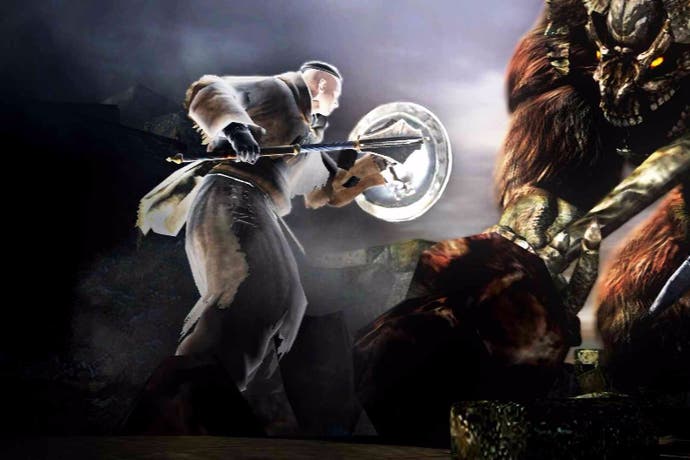The secrets of Dark Souls lore explained and explored
Pretty Nito.
"No matter how tender, how exquisite, a lie will remain a lie." - Lord Aldia
Karl Popper wrote a short-but-sweet essay called "The Conspiracy Theory of Society," in which he pours scorn on various ideas about one group or the other secretly running the world. The piece suggests this apparently-modern worldview can be traced back to Homer, "who conceived the power of the gods in such a way that whatever happened on the plain before Troy was only a reflection of the various conspiracies on Olympus." The squabbling of the gods, their alliances and contests, both give meaning to and excuse the actions of humans.
A key influence on Dark Souls is western mythology, most obviously the visual parallel between Gwyn and Zeus, ranging from the classical pantheons of Greece and Rome to Anglo-Saxon, Welsh and Norse equivalents. This roots Dark Souls' lore in aspects of historic mythology to an end far greater than mere reference - the creation and use of mythology is a key theme in Lordran, and real world examples act as the comparison point for how this happens. And in using such threads to construct its world, Dark Souls crafts a web of conspiracy theories.
This makes any summary, much less one hoping to cover Dark Souls' narrative structure and techniques as well as lore, more interpretative than a straight presentation of verifiable facts. Lore-hunting in these games is a noble pursuit, and both Dark Souls and Dark Souls 2 are well-served by a large community of youtubers (the best starting point is EpicNameBro's channel.) I'll summarise the key narrative beats of both games but, for the sake of length and sanity, it's impossible to go into real detail on the many (brilliant) side-stories both games contain.
A starting principle with Dark Souls' narrative techniques is that familiar words are used as disguises. We all have a sense of meaning for what a soul is, for what humanity might be, but these terms in Dark Souls have a specific meaning which must be reverse-engineered out of what we are told and can observe. This is one of the ways Dark Souls gradually constructs meaning: things like a unit of currency are often arbitrary in video games, but here the economic role of Souls ties into the larger cultural and economic systems of Lordran. We as a player collect souls, use them to gain more power and buy things, and therefore in this brutal landscape it makes sense that souls are desired not just by us, but by others. Souls are an object of obsession for many characters and, in the case of the Lord Souls, worship. There are coins in the game which have no value in Lordran, just to drive home the point.
This doesn't mean everything can be explained - this is still a fantasy game about dragons and gods that features, among other examples, a talking cat and a sentient, courtly mushroom. But the point is not the believability of individual details so much as their fitting within a larger context where each supports the other - a coherent world. One of Dark Souls' most iconic aspects is the bonfires that dot Lordran, for example, and their function as a checkpoint/respawn for the player. How could this mechanical necessity be a part of the lore? If we briefly digress on Gwyn, the mythology's central figure, even elements like this are explained.
The starting point of Dark Souls' world is the everlasting dragons, which in the brief snatches we see seem to rule the world comfortably. Humans are around at this point but very much an underclass. Four individuals discover the First Flame - Lord Gwyn, the Witch of Izalith, Gravelord Nito and the Furtive Pygmy - and from this it granted four Lord Souls. Shortly thereafter Gwyn leads the Witch and Nito against the everlasting dragons and, with the help of traitor Seathe the Scaleless, they destroy them and the Age of Fire begins - the gods rule.
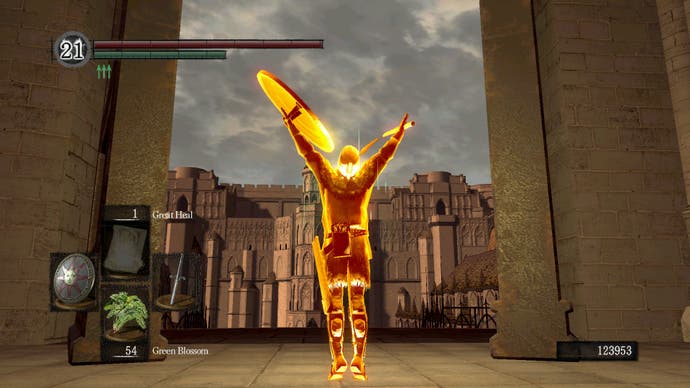
The player wakes in Lordran thousands of years after these events. Here is the story of Dark Souls if the players moves through it and does what they're told. You wake in the Undead Asylum, and shortly thereafter are told for the first time you're the Chosen Undead - a phrase that will be repeated many times, by many different characters.
You're taken to Firelink Shrine, where an NPC tells you to ring the two Bells of Awakening and you'll discover what to do next. After this a serpent, Frampt, appears and tells you that Lord Gwyn has linked the fire and you are destined to succeed him. Succeeding the Lord of Sunlight sounds pretty heroic! You reach Anor Londo and are given the Lordvessel by Gwyn's daughter Gwynevere, and Frampt tells you to fill it with Lord Souls (by killing certain bosses) before succeeding Gwyn.
What's important to understand about this plot is that it plays on the expectations a player may have of how a typical video game is structured. Particularly ingenious is that the boss fight against Ornstein and Smough, the pinnacle of the game's first half, features a typically game-y mechanic whereby one of the pair becomes a 'super' version halfway through - and after emerging victorious you're granted the Lordvessel, a crucial lore item that's also a great power-up that allows warping between bonfires. Anor Londo's a tough area, you've just beat a tough boss, and a generously-proportioned goddess calls you nice things and hands over a macguffin that opens new areas.
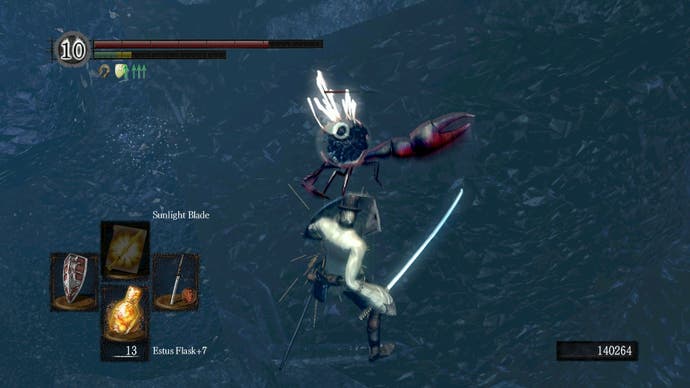
The fact you're hyped up as the Chosen Undead by various NPCs, and there are legends about your destiny, makes this a masterly setup. It is a standard, almost cookie-cutter videogame narrative progression - and therefore the perfect way to fool a player. At the end of the game, following this path, you defeat Gwyn, link the fire and are consumed by it in the process. GG.
Discovering what's really going on is a matter of curiosity, and exploring off the beaten path. One point that it is important to understand, because it's why the effect of Dark Souls can be so powerful, is that the game doesn't care if players realise they're being duped or not. There are hints, of course, but no heavy-handed nudges, and so the process of unravelling Lordran's history acquires an illicit air - like you're doing something you're not supposed to.
This is the Fisher Price version of what's really happened. The recipients of the four lord souls weren't really a team. After acquiring this enormous power three of them - Gwyn, the Witch of Izalith, and Nito - did work together to take out the Ancient Dragons, but the Furtive Pygmy took no part. After this Gwyn and the Witch are in cahoots during the Age of Fire, but Nito seems to be at one remove.
All is well, grand civilisations are built, and then one day the First Flame starts to fade. This understandably perturbs the gods, as it's their source of power, and their dire fear of the darkness that awaits leads them to seek solutions. The Witch of Izalith, a master of flame sorcery, attempts to recreate the First Flame - which seems logical. But this goes badly wrong and instead creates the element of Chaos, which spawns demons and acts essentially like wildfire - if the First Flame is a nice fire keeping you warm, Chaos burns down the house.
This act completely screws over the Witch and her children - she's transmogrified into a pathetic insect thing forever held and tormented at the centre of the experiment (the Bed of Chaos), her young son is transformed into a permanently-suffering giant lava baby (Ceaseless Discharge), two of her daughters are turned into demonic spiders, another stands guard in Izalith, and another three are unaccounted-for and presumed dead. The final daughter, Quelaana, invents Pyromancy from this new element and teaches it to humans - perhaps an act of atonement but, as the player finds out when sufficient mastery is achieved, also a way of helping someone who might be able to kill her tormented family.
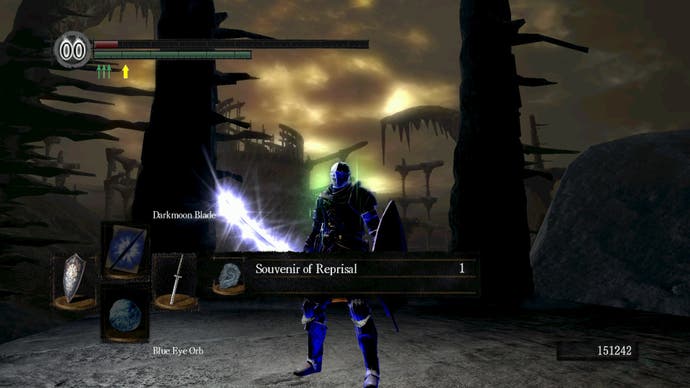
The consequences for the wider world were even worse. The Chaos in Izalith is now producing innumerable demons, a new creature born of this new element, and also permanently taints the land surrounding it - Blighttown sits atop a nightmarish poison swamp, and Pyromancy is the only 'magic' that deals in poison and toxin. Regardless, Gwyn and his knights go down to fight the Chaos demons back - and in the process, his Silver Knights' armour is charred, creating the Black Knights. This war was clearly a losing one, as at the time of the game Izalith has simply been sealed-off from the surface world. The flame still fades, and one of Gwyn's most powerful allies is gone.
At some point after this event Gwyn decides on his final course of action. We know from his Lord Soul that, before leaving, Gwyn parcels out almost all of his power - he splits his soul between the Four Kings of New Londo and Seathe the Scaleless. Rather than trying to relight or recreate the First Flame Gwyn instead decides to feed himself back to it and, by offering such a source of power, maintain the Age of Fire. The Lord Souls were part of the First Flame, after all. In this process the Lord of Sunlight burns and becomes the Lord of Cinder, and most of his remaining knights are left as ash.
It is unclear whether the end result of linking the fire - that is, both the myth and the spread of bonfires across Lordran - was predicted by Gwyn or, far more likely to my mind, another disaster. The disaster scenario works because it is this action that creates the undead curse. Gwyn upsets the natural order of things by linking his soul, the greatest of the Lord Souls, to the continued existence of the First Flame - which can now neither truly die out, nor regain its original brilliance. The lesser souls of Lordran are bound by this sacrifice. At death their souls and humanity are lost but, shortly afterwards, their vessel is re-formed at the nearest bonfire and what was lost still exists elsewhere in the world. There's a reason the darksign, which brands the undead, is a flaming circle.

The bonfires serve as tributaries to this central flame, and the fuel they run on is humanity - when you 'kindle' a flame to get more Estus, a ritual of the Way of White, you sacrifice humanity, and so too when you reverse hollowing. That is, the followers of Gwyn have ritualised this act within Lordran's culture. The word bonfire is a medieval term that combines bone and fire, and indeed when we examine the bonfires of Lordran closely it is easy to see they are a pile of bones.
There is a lot of weird terminology and meaning here, so perhaps it's best to put it in the plainest terms possible. Gwyn, in an effort to sustain the Age of Fire beyond its natural course, has created a system whereby the essence of lower lifeforms - souls and humanity - are burned as fuel.
Let's step back from that for the moment, and think again about the Chosen Undead story fed to the player. Gwyn's involvement in this modern-day illusion is unknowable, because he's a husk, but the primordial serpent Frampt together with Gwyn's son Gwyndolin perpetuate this myth that, in theory, will see one undead after another collect enormous amounts of souls and humanity then sacrifice everything as fuel for the First Flame. Frampt plays the role of benevolent guide, but Gwyndolin is hidden in Anor Londo and uses much more elaborate deceptions (see 'Gwyndolin - Master of Puppets?')
The primordial serpents Frampt and Kaathe are essentially unknown actors, the only real hint towards their purpose being the adjective - which is to say, they existed before the Age of Fire - and the fact we know a "toothy serpent" brought the Abyss to Oolacile and Kaathe did the same with New Londo. Frampt does gives us one of the few solid chronological tidbits around, which is that it's been 1000 years since Gwyn linked the flame.

To briefly digress, the online aspects also tie into these various actors and goals. Act as a Darkwraith for Kaathe, and you collect humanity to bring the Age of Dark ever-closer. This group is directly countered and invaded by Gwyndolin's Blades of the Darkmoon, who hunt Darkwraiths and steal the humanity back. Other groups, like the Forest Covenant, are dedicated to more specific goals like guarding the grave of Artorias, while of course the Warriors of Sunlight represent jolly co-operation and - possibly - how "the old god of war still watches closely over his warriors." Pulling PvP and PvE into the lore so elegantly is one of Dark Souls most subterranean but impressive achievements.
Are you the Chosen Undead? Probably not, and in fact you're surrounded by proof this isn't the case - all those other corpses, fat with souls. The Chosen Undead storyline is a myth, established in order to make undead collect large amounts of souls and humanity and feed it to bonfires in a hopeless quest. Even if they succeed, great! More fuel. This is showing how stories can mislead without their audience (or target) ever realising it.
If this was all Dark Souls was about then it would merely be a fantastic story. But what elevates it further is how it uses the nature of gaming itself - interactivity - in order to make the player an active participant, or perhaps a better term would be an active dupe. This is a myth but it is also about the creation and purpose of myths, and explores the latter through your actions or lack thereof. Myths are not simply handed-down stories from humans past, but a reflection of a particular culture and author/s agenda.

Perhaps the best way to exemplify this is how we uncover the story of Artorias the Abysswalker. Artorias was a legend in the original release, in the sense he wasn't in the game, and Ingward of New Londo seems to think he might still be alive: "Long ago, the knight Artorias traversed the Abyss. If you can find him, and learn from him, the Abyss may prove surmountable."
Artorias is not alive because, after fighting the Great Grey Wolf Sif, we learn from her soul that she "guards the grave of Artorias the Abysswalker." The setting for this battle, an enormous gravestone surrounded by lesser gravestones and countless weapons, seems to fit this sense of a grand hero. Three items can be made from this soul which tell us, variously, that Artorias "hunted the Darkwraiths," and his sword was "cursed when Artorias joined a covenant with the creatures of the Abyss." Further to this his ring can be found in Darkroot Garden which tells us he was one of Gwyn's four knights: "Artorias had an unbendable will of steel, and was unmatched with a greatsword."
There is more about Artorias in the original game but, even here, we're being fed information in at least four different ways - through character dialogue, through the environment of the Sif battle, through Sif's greatsword technique (!), and through item descriptions. Look closely enough and some of it may even seem contradictory, nevermind the fact that Ingward is way off in thinking the guy's still alive.
Regardless, the importance of Artorias is as a legend - the only man in Lordran's history to face and battle successfully against the abyss, and thus given the sobriquet Abysswalker. Dark Souls' DLC was named Artorias of the Abyss, takes place in the past, and shows the truth behind the legend.
Artorias was a knight of Gwyn, and did go to Oolacile to fight the Abyss, but instead of a hero we find a corrupted figure - one arm broken, the Abyss seemingly seeping from his body, he nevertheless heaves his greatsword against us and moves with incredible grace and power. This is a tremendous boss fight, one of the best the Souls series has produced, and so gives us another narrative angle on Artorias - THIS is why he's a legend - while undercutting almost everything we already know.
After the fight we can see the trail of blood left by Artorias as he fled the Abyss, speak to his companion Hawkeye Gough, and press on to discover for ourselves what felled him. We find a young Sif in the Abyss, hidden and protected by Artorias' abandoned greatshield, and discover coalescing humanity sprites that simply try to crowd and 'touch' the player rather than attacking - which is deadly and a great counter for an unbendable will of steel. And then we face and conquer Manus, the source of the Abyss, and do what Artorias couldn't.
The legend of Artorias was thus just that - a legend, based on the player's own actions but obscured from history. This is not some moment of triumph for the player, so much as the usurpation of a hero - and a wider clue about the reliability of myth. Ingward didn't lie to us, he didn't know. Sif guards Artorias' grave because it holds the ring required to traverse the Abyss - and she's seen what it will do to any successor.
Artorias's victory was your victory, but history tells a different story and so the Abysswalker goes down in legend. Why? Perhaps because it gave those who would face the Abyss in the real hero's absence some vestige of hope - throughout history myth has had a political function, and so too we find this in Dark Souls.
This is not merely a neat bit of rug-pulling, but exactly the way myths are formed. No-one knows who Robin Hood was, or if he was anyone - much less whether he robbed from the rich and gave to the poor. I once looked into the Greek hero Troilus and discovered, to my astonishment, that almost no contemporary sources for his legends survive - and those that do are mere fragments. The Troilus and Cressida story that had first piqued my interest was a medieval invention, and before this point Troilus was really only known for dying at the hands of Achilles. Over centuries a name can lose and gain all manner of associations, and we have no way of discovering 'truth' beyond reading between the lines.
So too must any conclusions we draw from Dark Souls be inexact. Souls seem to be what animate beings, what gives them life, but humanity is what gives them sentience and by extension free will. The typical state for an undead in Lordran is hollow - they have souls but, without humanity, are basically feral, mindlessly aggressive. So the two elements are complementary and, as we see in the polar opposites of Gwyn and Manus, an over-abundance of either has negative effects.
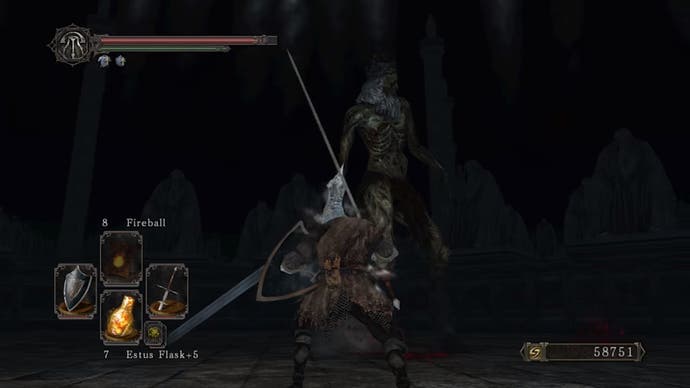
This complementary nature is because humanity is, of course, a type of soul - the Dark Soul. We know souls can be split, because Gwyn's Lord Soul tells us he did the same before setting off to link the fire, but in the case of the Furtive Pygmy the split was much larger and more diffuse. It chose to share a a tiny shard of this Lord Soul with every hollow, a plainly selfless act that does not foresee the Dark Soul will later attempt to re-coalesce - and be viewed by Gwyn as a resource for his own ends.
Manus is often identified as the Furtive Pygmy, though both Gough and Chester refer to him as 'primeval man' without the definite article - Manus is definitely of that era, but it's impossible to say. "[Oolacile] awoke that thing themselves," says Gough, "and drove it mad."
One item associated with Manus has always stood out to me: the broken pendant. At Dark Souls' release Miyazaki gave an interview where he said the starting gift he'd choose in-game was a pendant, and this became the basis for increasingly wild community speculation about this having some unknown revelation. It doesn't, but this didn't stop the hoping, the theories, and the creation of new myths. Manus, the closest thing we get in Dark Souls to pure humanity, was created for DLC post-release and is driven wild by a broken pendant.
This is obviously a nice meta-poke at elements of the fanbase, but it also hints at the negative side of humanity, or dark. These are behaviours like obsession, fervour, blind faith, even neediness - fine in moderation, but all can lead to terrible behaviour if unchecked. After defeating Manus you can trade his soul for a spell called Pursuers which has some odd lines at the end of its description: "The will feels envy, or perhaps love, and despite the inevitably trite and tragic ending, the will sees no alternative, and is driven madly toward its target." Perhaps that is ultimately what defines humanity in Dark Souls, and it's an idea the sequel explores at length: we just can't let some things go.

A common and unfortunately foundational mistake with Dark Souls 2 is referring to the player character as the Chosen Undead. That was Dark Souls' myth but Drangleic and Lordran are different beasts in many ways - not least because the player character enters Drangleic through an explicitly timey-wimey wormhole that frames this as some sort of pocket universe. Time is convoluted in Lordran but, with Drangleic's habit of diving into memories, the chronology gets even more criss-crossed.
This is used to often-great effect throughout the main storyline, which is set up to tease players familiar with Dark Souls into thinking something similar is going on here. But Drangleic is an era long, long after the events of the original game and countless civilisations have risen and fell in the meantime. Gwyn was the mightiest of gods but, as becomes another theme in Dark Souls 2, his name is long-lost.
Memory is a good place to start because the mechanical equivalent of humanity this time around is the human effigy - a doll that traditionally holds memories of the dead. The idea is that by gazing upon this doll our character is reminded of who they are, and this prevents hollowing, and in the rest of this world we meet countless characters who have forgotten or are gradually forgetting who they are and what their purpose was. Many simply go through familiar motions, their original motivations long-lost to time.
A beautiful game-long payoff here is that the player character first seeks Drangleic because they're losing their memories. The opening cutscene shows a family and home, before the faces collapse into grains of sand. Your character is seeking a cure for this curse but, from the moment you arrive in Drangleic, all that other characters talk about is becoming a king. It's common for players, by the time they've reached the game's close and perhaps become a king, to forget why they first arrived.
The endless cycle of Dark Souls is another framing device, but Dark Souls 2 is often misunderstood as being simply about cycles, a neverending repetition of the same story with the same actors. But the core storyline of King Vendrick and his brother Aldia is about something more specific: the question of what happens when the myth a civilisation is founded on has been rejected.

If there is a Chosen Undead in Dark Souls 2, it is King Vendrick. Long before the events of the game he conquered the holders of the four Great Souls, as the player does in Dark Souls, but stopped before taking the final choice. An early discovery for the player lies in the basement of the Majula mansion - the Lordvessel, where the player deposited their great souls before facing Gwyn, lies shattered.
Vendrick and his brother Aldia had somehow intuited the nature of their world's cycle and, rather than starting another, resolved to find a route beyond darkness and flames. The smashed Lordvessel is a neat hint towards this but also helps explain why the player can hunt Drangleic's four Great Souls afresh - after which lorecat (not her official title) Sweet Shalquoir says "Long ago [Vendrick] smelled just like you."
The story of King Vendrick is told in detail, and after Dark Souls 2's DLC players could even talk to him through his memories, but what matters is that his reign comes under threat from - you guessed it - the Undead Curse. After refusing to link the fire he and Aldia founded Drangleic together and set their energies to researching Souls and the Undead Curse, both eventually comprehending the cycle that lay beneath it all. Weaponsmith Ornifex tells us "Vendrick came close to unlocking the essence of the soul" and, after conquering the three DLC kings, we discover he found a way to stop the symptoms of hollowing.
What is interesting about Vendrick is how he, too, eventually falls for a myth in a beautiful package - and may be more like Gwyn than we expect. The dying Captain Drummond tells us that "long ago, the King crossed the seas, pillaged the land of Giants, and brought back a 'prize.'" This prize is left unnamed and there are many candidates for it, but the one who convinced Vendrick to plunder it was his queen, Nashandra.
A theme in Dark Souls 2 is fragments of the Dark Soul, released when Manus was defeated, re-coalescing. They seek out strong souls, taking the form of queens to the great kings of Drangleic, hoping to eventually usurp them. Nashandra is Vendrick's queen, adored by him, and causes his ruin. The Giants Club says "King Vendrick, in adherence to Queen Nashandra's counsel, led his armies north in an effort to subjugate the Giants, and claim their powerful souls for his own."
The long and bloody war waged by the giants in retaliation would tear apart Drangleic, though the Phyrric victory did allow Vendrick to create the golems that would construct Drangleic Castle. Vendrick was smart enough to see his way past the binary cycle, in other words, but still ended up duped by a fragment of the Dark Soul. It's worthwhile pointing out, too, that Nashandra has no love for anything but power - when you turn up, a better option, she puts it as plain as day: "Visit Vendrick. We have no need for two rulers..."
Aldia too followed his own research, and evidence of Vendrick's use of it is scattered around Castle Drangleic, but the brothers eventually had a falling-out - almost certainly because Aldia's methods, involving countless sacrifices and the creation of grisly abominations, went too far. "King Vendrick condemned his own elder brother to the mansion. They both sought the truth, but through different means, and their fervor meant the eventual withering of their familial ties."
One of these experiments is the Emerald Herald, the player's guide, who is "born of dragons, contrived by men." Aldia saw the way to escape fate as connected with something outside of life and death - the everlasting dragons. The Emerald Herald was thus intended as the last Firekeeper, one that would - through linking dragons to the bonfires - end the undead curse. Given that we're playing the game, file this one under 'nice idea.'
Aldia did not, however, give up so easily. He is the eponymous Scholar of the First Sin, and identifies this as Gwyn's attempt to defy the world's natural order by linking the fire.
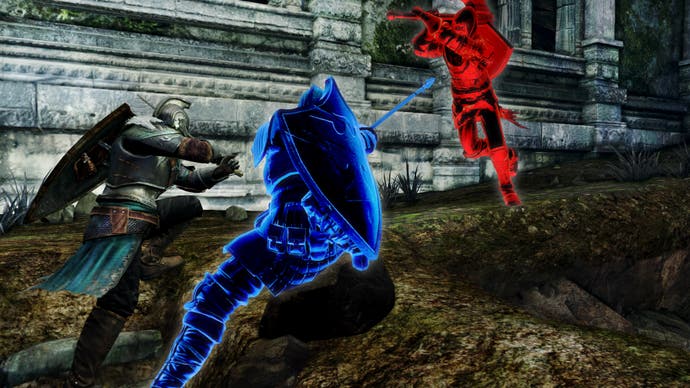
"Once, the Lord of Light banished Dark, and all that stemmed from humanity. And men assumed a fleeting form. These are the roots of our world."
Fleeting surely carries a little of its original meaning here, which is to float, passive to destiny rather than a player in it. Aldia tells the player he "sought to shed the yoke of fate, and failed" but now waits for our answer. He is transformed himself, justice perhaps for his experiments on others, but seems to have succeeded only in escaping the cycle personally rather than breaking it - Aldia is unique among bosses in dropping no items or souls on his defeat, and has the ability to appear anywhere in Drangleic he wishes.
One of Dark Souls 2's greatest touches is that, if you enter the kiln to either link the fire or usher in an age of dark (the ending choices for Dark Souls) the same cutscene plays - showing your character entering the kiln and the door closing. Because it doesn't matter which one you choose, the cycle continues. There is no choice.
A new ending is unlocked through meeting and eventually defeating Aldia, one where the player character strides off, their clenched fist showing determination, while Aldia narrates that there is no path or answers: "And yet, we seek it, insatiably... Such is our fate."
Which is all well and good, if a little pat. The nature of Dark Souls 2's storytelling is more direct and has less room for ambiguity, which is why some Souls fans remain unconvinced. But let us at least acknowledge that, over its DLC and subsequent re-release as Scholar of the First Sin, the story of Drangleic filled-out into a more individual take on the concept than it first seemed. And one of the beauties of From Software's approach to roleplaying is that your personal journey has meaning regardless of the destination - or any choice at the end.
One thing it does lose through this, however, is that quality of enmeshing a player with the concepts it's describing. In Dark Souls the player is a pawn, and realising this has a powerful impact that continues to resonate as the deeper meanings of the narrative unfold. In Dark Souls 2 the player is told they're a pawn, that we're all prisoners of fate thanks to this ghastly cycle, and then eventually you're allowed to break free of it by virtue of being handy with a greatsword.
As narratives the games are operating on different conceptual levels, but making this distinction is not merely about slamming Dark Souls 2. The original game has a confluence of factors that root lore ideas more firmly in the gameworld but, more importantly, it would have been impossible to pull the same trick twice.
Dark Souls 2 is often over-simplified as a sequel about being a sequel, a line so trite I've used it myself, where the question it ends up asking the player is trickier: how can one escape fate if you don't want to? As a quick thought experiment, what if Bloodborne had been called Dark Souls 3? Would everyone have been happy with a magnificent game, or would many have complained that it wasn't Dark Souls-y enough?
Video games are chronically terrible at storytelling and it's because interactive narrative relies on new techniques that are little-understood by most studios. Everyone understands that the player should be the principal actor, but this does not mean they need to be the principal focus of the storytelling at the same time - only the Souls games seem to build worlds designed to reflect and play with these expectations.
The genius of Dark Souls as a narrative experience is not in the game's systems, brilliant as they are, but in the principles on which it is been structured. At the most basic level the story is a puzzle, and one made up of different varieties of piece. From Software expects players to pay attention to architecture, enemy placement, armour details, item placement, item descriptions, geography, NPC dialogue, and a hundred little one-off touches that are easily missed. There is always more to find and more to see, and it plays with many types of ambiguity to leave great spaces for imaginative theorising - in its greatest flourish, making the player an active participant in assembling or re-creating the world.
I do not say that appreciating the Dark Souls games is easy, and accept they're not for everyone. But in utilising such sophisticated techniques it shows a level of faith in players that most AAA studios wouldn't dare and, just a thought, maybe that's why they're the best games of the modern era.
If you're currently playing the latest game, you might like to check out our Dark Souls 3 guide.
